The generation of high-energy, dense and collimated photon beams is of great interest both to fundamental and applied research. An international team of physicists led by Matteo Tamburini of Christoph Keitel’s Division at MPIK has demonstrated that a pulsed, ultrarelativistic electron beam crossing a sequence of thin aluminium foils both self-focuses, therefore increasing its density, and efficiently yields a collimated gamma-ray pulse with more photons per unit volume than electrons in a solid. After passage of 20 foils, more than 30% of the electron beam energy is converted to gamma rays. This occurs because the strong electric and magnetic fields accompanying the ultrarelativistic electron beam are “back-reflected” as the beam crosses the foil surface. Similar to an electromagnetic wave colliding with a mirror, the reflected magnetic field is nearly the same as the beam magnetic field, whereas the reflected electric field has the same amplitude as that of the electron beam but opposite direction. As a result, at the foil surface, the total electric field acting on the beam is nearly zero, while the total magnetic field is nearly doubled. This strong azimuthal magnetic field focuses the electron beam radially, and consequently triggers collimated high-energy photon emission.
Such extremely dense beams enable physics studies of matterless photon-photon interactions ranging from matter-antimatter creation from light, light-by-light scattering and searches of possible new physics in the interaction of photons with yet undiscovered particles, to laboratory astrophysics studies. Here, dense neutral relativistic jets of electron-positron pairs are generated from the dense gamma-ray pulse. In turn, these dense electron-positron jets enable unprecedented studies of the collective processes that shape high-energy astrophysical environments such as gamma-ray bursts and blazar jets, therefore providing insights into these exotic systems.
Original publication:
Extremely Dense Gamma-Ray Pulses in Electron Beam-Multifoil Collisions, A. Sampath, X. Davoine, S. Corde, L. Gremillet, M. Gilljohann, M. Sangal, C. H. Keitel, R. Ariniello, J. Cary, H. Ekerfelt, C. Emma, F. F., H. Fujii, M. Hogan, C. Joshi, A. Knetsch, O. Kononenko, V. Lee, M. Litos, K. Marsh, Z. Nie, B. O'Shea, J. R. Peterson, P. San Miguel Claveria, D. Storey, Y. Wu, X. Xu, C. Zhang, and M. Tamburini, Phys. Rev Lett. 126 (2021), DOI: 10.1103/PhysRevLett.126.064801
